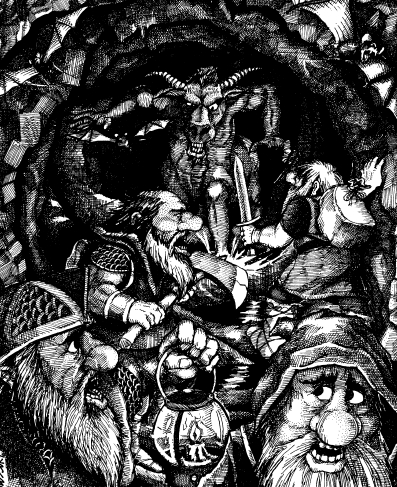| Dragon | - | Races | - | Dragon 62 |
Running a campaign wherein everyone is of a certain race,
creed, alignment, or the like can be very interesting. Certainly it
doesn’t have all the variety that regular Dungeons & Dragons
has,
and should be used only as a sideline to the main action in a
campaign. It can, however, provide a stronger feeling of group
cohesiveness, allow for group goals that are more easily agreed on
by everyone, and in a well-run game, it can give the players a strong
feeling for the role and capabilities of that race, alignment, etc.
This article will give some ideas to those Dungeon Masters who
have players with a special fondness for being short, bearded, axetoting,
and who smile when the DM announces an orc encounter.
In AD&D, dwarves can work as Fighters,
Thieves, Fighter-
Thieves, Assassins, and Fighter-Clerics. Usually this last category
is
not allowed, but I would make an exception in an all-dwarven
campaign, to give the party a chance to conserve its strength; dwarven
Fighter-Clerics, of course, will interact only with other dwarves.
Most times there will be little problem in mixing alignments in alldwarven
expeditions, as the dwarves are generally united against the
many enemies they face in the worlds they occupy. Most dwarves
are lawful good, though some worship Norse gods and are more
chaotic good. Dwarven Assassins tend to be lawful evil, and may
function as spies and guerrillas in dwarven adventures; Thieves and
Fighter-Thieves make excellent scouts. It is very rare for dwarves
to
fight or steal from other dwarves, and brotherhood should be carefully
emphasized by the Dungeon Master.
Traditionally, dwarves have fought against a number of creatures more
or less constantly for millennia. At some time in the
remote past, it is usually assumed in campaigns that dwarves and
elves had a falling out (as in Tolkien’s mythos). A lot of animosity
was
created between the races at the time, but has largely been modified
today to a mutual dislike. Dwarves and men have fought at times for
the gold in the dwarves’ horde, and roving gangs of brigands,
bandits, thieves, and so on are a major concern. Dragons have an
even stronger lust for treasure, and in the past have decimated
dwarven strongholds for their wealth. At rare times, a greater
demon, devil, or wizard will draw plans against the mountain race.
Ogres and giants have attempted to impose their will upon the
smaller folk many times, and dwarves have learned special tactics
against them (fighting so well that the giants get a -4 to hit when
in
combat with them).
The most hated of all enemies, however, are the “goblin-races”
of the kobolds, goblins, orcs, and hobgoblins. The wars between
dwarves and the goblins and orcs have a history almost beyond
memory, and the mutual hatred seems inborn. All of the dwarven
players in my campaigns have related to this idea very well, and few
have passed up a chance to deliver a well-aimed hand axe or
crossbow bolt in an orc’s general direction. Even the shy players
have opened up to do combat with an orc patrol, or use their
multiple-strike-per-melee-round fighting ability against goblins and
kobolds to carve a highway through their armies. Setting up encounters
with the above creatures can deepen the feeling of kinship
among the dwarven players and guarantee a lot of excitement in the
game as a whole.
For a general backdrop to an all-dwarven adventure, a history
something like Tolkien’s should be used, describing a glorious past
now in shadow because of the depredations of various monsters.
The DM should draw out and describe the dwarven caverns from
which the group hails, including rumors and knowledge of other
dwarven lairs, families, legends, and the like, as well as locations
of
suspected or known monster lairs.
From this point, missions and individual adventures take shape.
Perhaps a pass has been noted through which orcs drive their wagon
trains of stolen goods, or a valley where a hill giant lives who slew
a
dwarven chief some years ago, or a spot where warg-riding goblins
on scouting missions have been known to stop. Rumors of special
treasures may crop up in the writings of the dwarves’ small library,
leading to a Rod of Resurrection (vital to the characters’ survival
unless a human Cleric NPC can be found, as dwarven Clerics cannot
reach the level necessary to perform a Raise Dead).
As the characters become more powerful and their clan horde
fills, the treasures searched for may likewise expand to include
searches for mithril or adamantine armor, artifacts, and fabled gems.
What the adventuring dwarves do with their treasure is up to them,
of course, but the option should be open to donate to the clan horde
to benefit all the dwarves. If the characters reach very high levels,
they might even take charge of the clan or even the family of dwarves
they come from.
In any case, the DM must be careful not to make this a “giveaway” campaign,
or the rewards gained become cheapened.
Always there are the enemies of the dwarves, and they are powerful,
though they may not be cohesive.
An all-dwarven group can provide an interesting change of pace
for a campaign, particularly if a group seems to enjoy hand-to-hand
combat and loathes orcs. Dwarves are more than just another unusual
member of a dungeon party; they can carry a campaign in their
own right.
